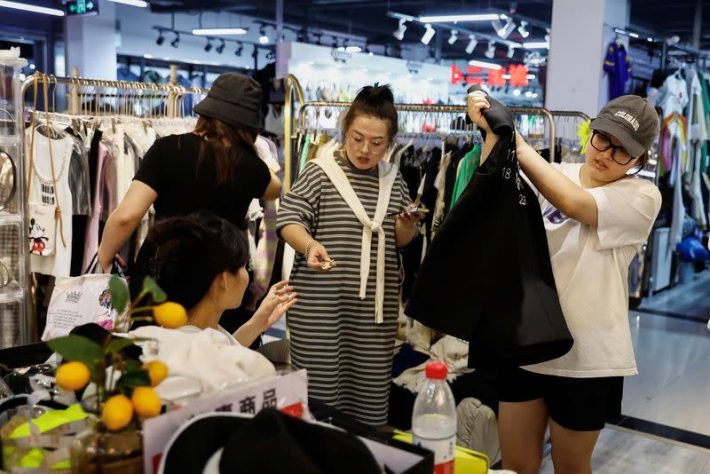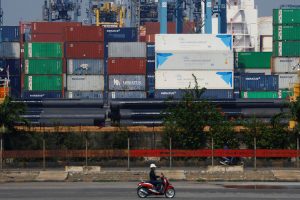Pockets of weakness continue in the Chinese economy, with factory-gate deflation persisting in December, despite exports edging up last month.
The central bank is expected to use more policy-easing measures to bolster the economy and policymakers are likely to be relieved by signs that trade will improve when borrowing costs decline as the year progresses.
But the protracted crisis in the property sector, cautious consumers and geopolitical challenges point to another bumpy year for the world’s second-biggest economy.
ALSO SEE: Global Trade Shrinks on Red Sea Woes But China Bucks the Trend
Exports grew 2.3% from a year earlier in December, customs data showed on Friday, compared with a 0.5% increase in November and beating the 1.7% boost expected in a Reuters poll.
Imports grew by 0.2% year-on-year, missing forecasts for a 0.3% increase but still reversing a 0.6% drop a month prior.
“The better export data is first and foremost driven by semiconductors and electronics, and the recovery on that side comes from a cyclical rebound in consumer demand overseas,” Xu Tianchen, a senior economist at the Economist Intelligence Unit, said.
Xu said the figure was also buoyed by a low statistical base since “there was severe disruption to exports last December following China’s abrupt reopening.”
Still, the improved Chinese export data last month joins those from South Korea, Germany and Taiwan in suggesting global trade is starting to mount a comeback, after higher interest rates in the United States and Europe crimped demand throughout last year.
China’s consumer, factory prices fell further
Last year, China’s exports fell in 2023 for the first time since 2016. The United Nations had warned of a likely contraction in goods trade by $2 trillion or 8% in 2023.
South Korea’s exports, a closely watched indicator of global trade, rose for a third month in December, while the latest German export data for November surprised on the upside.
Analysts also anticipate that interest rates will drop at least 1.5 percentage points in the United States and Europe this year, which should improve demand for imported goods.
And yet, consumer prices in China fell for a third month in December while factory-gate prices extended a more-than-year-long decline, separate data from the National Bureau of Statistics showed, highlighting the persistence of deflationary forces in the Asian giant’s economy.
The consumer price index rose 0.2% in 2023, the slowest pace since 2009, and full-year producer price index fell 3.0%, marking the steepest downturn since 2015.
“The deflationary pressure in China’s economy remains as domestic demand is still weak. The property sector continues to weigh on the economy,” Zhiwei Zhang, chief economist at Pinpoint Asset Management, said.
Analysts expect more policy support measures over the short term to spur demand.
“Consumption will likely pick up into the Lunar New Year, but more stimulus is needed to boost household spending and eliminate deflationary pressure,” UBS analysts said in a note.
World Bank expects global growth to slow again
Chinese policymakers also will have to contend with underpowered overseas economies, with the World Bank on Tuesday warning that global growth is set to slow for a third year in a row.
“New foreign orders for Chinese producers increased significantly last month, but it’s not a long-term trend,” said Dan Wang, chief economist at Hang Seng Bank China.
Market reaction to the data was largely muted. China’s blue chip CSI300 stock index fell 0.17%, while Hong Kong’s Hang Seng Index stayed steady, as did the yuan against the dollar.
The world’s biggest energy consumer bought in record levels of coal and crude oil over 2023, as demand recovered form a pandemic-induced slump despite the economic headwinds. Iron ore imports also enjoyed a record-breaking year.
And soybean imports jumped for the first time in three years, as Chinese traders ramped up purchases, particularly from Brazil, to take advantage of cheaper beans from a bumper crop there.
But iron ore futures slipped on Friday, off the back of the CPI and PPI data, which pointed to soft demand prospects and dented investor sentiment.
Julian Evans-Pritchard, head of China Economics at Capital Economics, said he expected import volumes to improve in the near-term thanks to further policy support boosting demand for commodities.
“The ongoing cyclical recovery in economic activity will underpin a slight rise in core inflation,” he said in a note.
“That said, weak global growth and continued overinvestment in China means that deflation risks will continue to hang over its economy for some time.”
Most analysts say the uptick in exports will provide only a modest boost to domestic demand.
“Exports improved on the margin… but exports as a pillar for growth in China are not strong enough to boost overall domestic demand,” Pinpoint Asset Management’s Zhang said.
- Reuters with additional editing by Jim Pollard
ALSO SEE:
China Real Estate Funds Crash as Economic Gloom Persists
Evergrande Sells Key Shanghai Stake as China Property Weakens
China Consumer Prices Fall Fastest in 3 Years, Alarming Beijing
China’s Stock Index Near 5-Year Low After Moody’s Outlook Cut
Second Shadow Bank Rocked by China’s Property Crisis
























